Chris & Allyson vs. California (2014)
Day Three: Alcatraz. Fisherman's Wharf. Oakland and the USS Potomac. Tragedy and fine dining.
The greatest prison in the world is ignorance. Those within its walls shall never know the greatest joys of the human experience. The second-greatest prison is slavish devotion to metaphors. Coming in a close third is Alcatraz. Which, come to think of it, is probably the actual greatest prison, because you can escape ignorance with a few Google searches, and Alcatraz itself is a giant metaphor.
So: The greatest prison in the world is Alcatraz. Because my wife deserves the greatest things in life, on our second day in California, we woke up at 7:45 to go there.
Alcatraz is a tiny island, but it gets more than a million visitors a year. If you want to avoid the crowds, you need to think ahead. Months before our vacation, I noticed that we'd be in San Francisco on Easter Sunday. With all the churching and brunching, I figured the first scheduled ferry that day would be empty. I convinced Allyson to agree to this plan right away, when waking up that early was still an abstraction and not the horrible reality. Also, Allyson is Jewish, so this seemed like a solid alternative to celebrating the resurrection of the one true savior.
This was crass manipulation on my part, and completely unnecessary. Allyson is not a hard person to plan a vacation with, because she has almost no interest in planning. She picks the hotels and mentions one or two things she might enjoy. After that she lets me schedule the rest of the trip tighter than the invasion of Normandy. She wasn't even bothered by the fact that she had been to Alcatraz before. Twice.
It also might have been crass manipulation on Allyson's part, because under her system, I carry close to 100 percent of the blame when any plan goes south. The key to any happy marriage is two people in love, each of them convinced that they are successfully screwing the other person over on a regular basis.
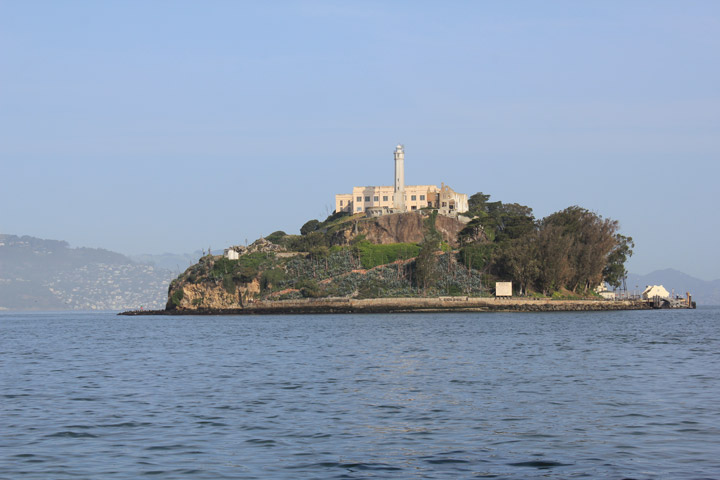
The approach to America's most famous prison.
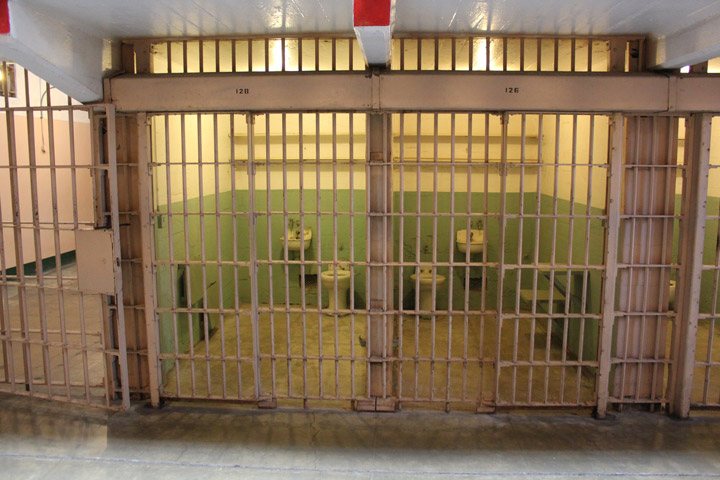
An apartment this size in San Francisco is $32,000 a month.
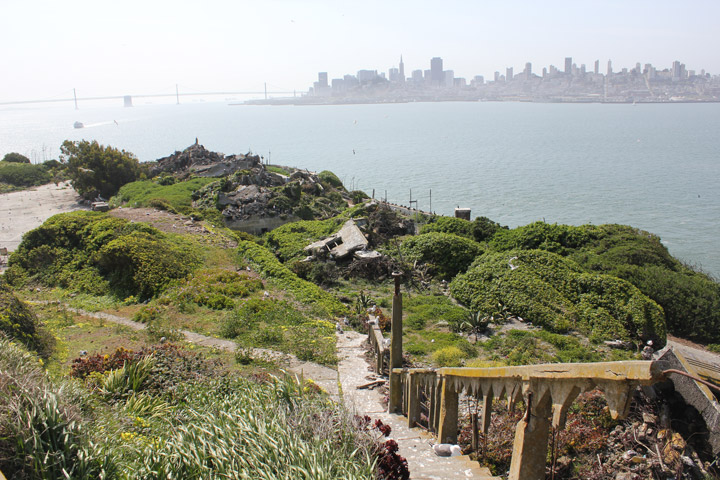
If you were imprisoned at Alcatraz, at least you had a view.
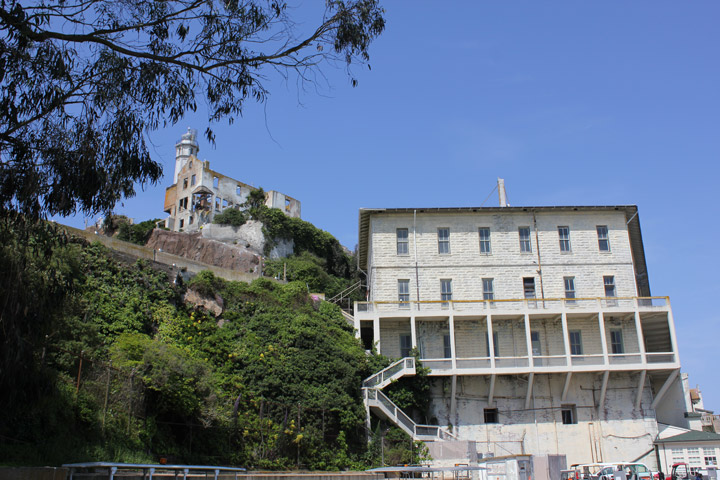
Some of the "outbuildings" on Alcatraz island, falling into ruin.
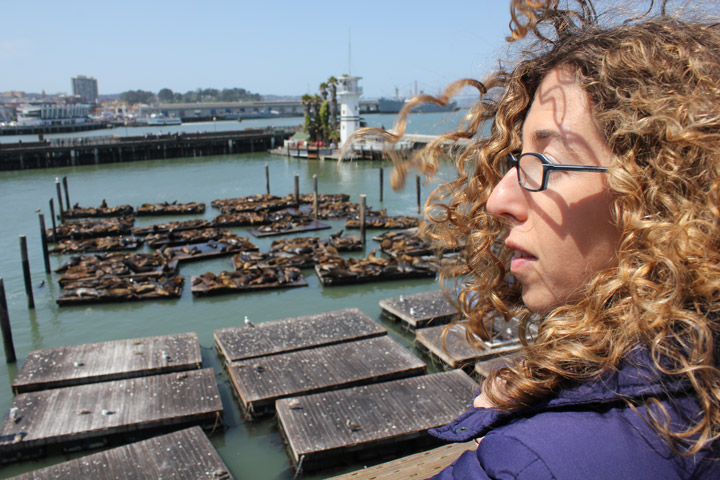
Checking out the sea lions at Fisherman's Wharf.
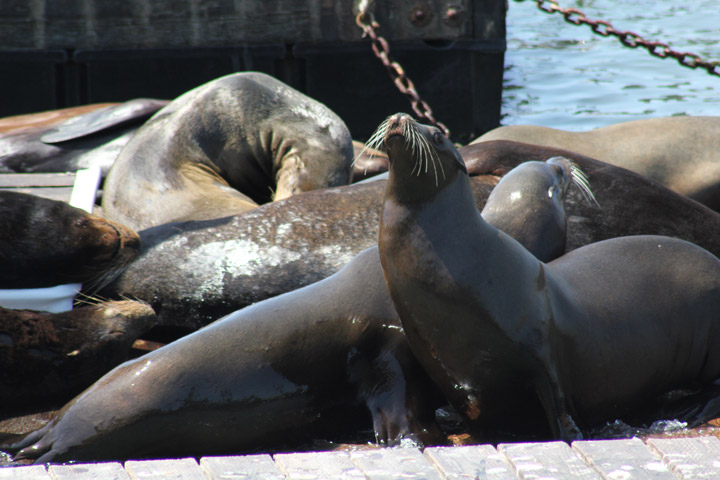
The smelliest residents of Pier 39.
After Allyson got her wake-up juice, we made the short drive to Pier 33. To honor Jesus' sacrifice, we made our own sacrifice, by paying $40 for parking. And then we got in a surprisingly long ferry line. Apparently, I underestimated the number of godless insomniacs who vacation in California.
It's only 10 minutes or so to the island, and the ride gives you great views of the city, the Golden Gate Bridge and the prison itself. We enjoyed a beautiful morning with bright sunshine, putting us in the perfect mood to learn about the many murderers and sociopaths who had made the journey before us.
The first residents of the island were birds -- "Alcatraz" is the Spanish word for "dear lord that's a lot of pelican s**t." No one wanted to live there, but it had a primo spot near the mouth of the harbor. So when we politely commandeered California from Mexico in 1848, it was decided that a lighthouse should go there. The Army also built a fort, entrusting that task to a civil engineer named Zealous B. Tower -- who is second only to Bushrod Washington for the greatest name in American history. The presence of a fort made the island an ideal place for imprisoning people who liked the Confederacy.
The military always has people to lock up, so Alcatraz flourished as a military prison for many decades. In the 1930s, it was transferred to the Bureau of Prisons, with the hope that it might house the most vicious prisoners in the federal system. Alcatraz was perfect for two reasons. First, if you somehow get out of your cell and try to swim to freedom, you will almost certainly end up a bloated corpse. Second, the first reason is psychologically soothing to senior citizens who worry about serial-raping mobsters escaping prison and stealing their hard candies.
It operated as a federal prison from 1934 to 1963, when it was closed because of infrastructure issues –the buildings were deteriorating, and people were finally getting grossed out by the lack of a sewer system. In 1969, some Native Americans started a two-year occupation of the island. This damaged a few buildings, left some graffiti, and probably fixed all of the problems facing Native Americans. Finally, the island was opened to visitors in 1973, so that children could learn about serial killers in a federally funded environment.
Alcatraz was the third prison I visited with my wife, because we enjoy metaphors for our marriage. HA! Seriously, marriage is like having a cellmate who would never shank you in the shower. May you all get life.
The ferry drops you at a landing, where a volunteer politely asks you not to be an a-hole during your visit. It's a short walk to the theater, in the basement of the old barracks where military officers and guards lived. We watched the introductory movie, which surpassed Park Service standards by being produced after 1978.
But the real attraction is at the top of the hill. The cell house is where the most hardened criminals in U.S. history marinated in their own stink for years on end. Hundreds of gritty dramas played out in that building every single day, starring people who violated the fundamental laws of society. Men who were once world-beaters saw their worlds reduced to cramped cells and numbing routine.
It was smaller than I expected, and I blame Michael Bay for that.
But what a tour! The great audio presentation includes narration from actual prisoners and guards. It explains some of the daily drudgery of prison, but it also walks you through the most violent action -- like the Battle of Alcatraz, a 1946 escape attempt that resulted in two dead guards and three dead inmates. You see some of the administrative offices, the exercise yard and the plaza with the lighthouse. When the winds were blowing the right direction, inmates could hear the sounds of parties and good times on the San Francisco waterfront. The brilliance of Alcatraz -- the giant F.U. to every inmate -- was that people could see what they were missing, about 1.5 miles away.
Away from the cell house, the island has dilapidated charm. The buildings are in the process of slow collapse, and birds have reasserted themselves as the alpha species. They do a nice job with the gardens along the paths, because every prison needs a dash of color.
We left Alcatraz after a few hours, as the crowds were starting to thicken. We were satisfied that we completely understood the inmate experience, except for the part about being able to leave after a few hours. The ferry dropped us back at Pier 33, and we decided to celebrate our freedom with lunch on Pier 39, in the area known as Fisherman's Wharf.
For many generations, the wharf was heart of the city's seafood industry. In the 1970s it was redeveloped to serve an equally important, and less smelly, purpose. It is now the section of the city that most locals avoid at all costs, to stay away from the goddam tourists.
As a goddam tourist, I was looking forward to eating a stereotype for lunch. Tucked in between the Hard Rock Café and the Bubba Gump Shrimp Company, Pier 39 has a Boudin Bakery. Boudin has been a part of San Francisco since 1849, making sourdough bread for whatever grizzled person comes through the door. I had chili in a sourdough bowl. Allyson had a less-grizzled salad, but she also got a piece of sourdough baked into the shape of a bunny. They had bread in the shape of a crab, but it seemed more Eastery to bite the head off a rabbit.
The best part of Pier 39, though, is the sea lions. There's a sheltered area at the end of the pier with a bunch of square floating platforms, as seen in many coming-of-age movies set at lakes. And on any given day, those platforms are covered with fat, blubbery mammals.
There's a small (and free) information center affiliated with the nearby aquarium; a very friendly guy working there explained that the human activity around the pier created an unusual ecosystem, mucking with water temperatures and drawing in the kinds of things that sea lions love to eat. They started showing up in 1989, and eventually they were turned into a tourist attraction. On any given day there are hundreds of them chilling out on the platforms in between their food runs.
Most of them are guys, and they do the kinds of things guys do on the beach: sleep, make disgusting noises and fight. Sea lions constantly bark at each other, and bump into each other, and crawl on top of each other. They have very little in the way of personal boundaries. It made me nostalgic for the Jersey Shore.
This was a very special occasion for Allyson, who loves seeing animals. She's not a fan of camping, nature or the outdoors in general. She does not read about animals, she almost never watches animal documentaries, she does not donate to any conservation groups, and she has no particular interest in learning about ecosystems or biology. She just loves seeing animals -- preferably ones that do silly things or look good as a plush toy. In scientific terms, I think this is called being a girl.
It's great fun to watch Allyson enjoy things, so we stuck around for a while. Sea lions move very awkwardly out of the water, having to hump their way along the ground. It's like a whole species had too much Milwaukee's Best and is trying to get out of a lounge chair.
It was also good to let Allyson enjoy the sea lions, to make up in advance for what I was about to put her through. When we were done gawking at nature's at clowns, we got back in the car and drove over the Bay Bridge, the angry younger brother of the Golden Gate Bridge. Within a few minutes, we were parking the car a few blocks from another waterfront. In Oakland.
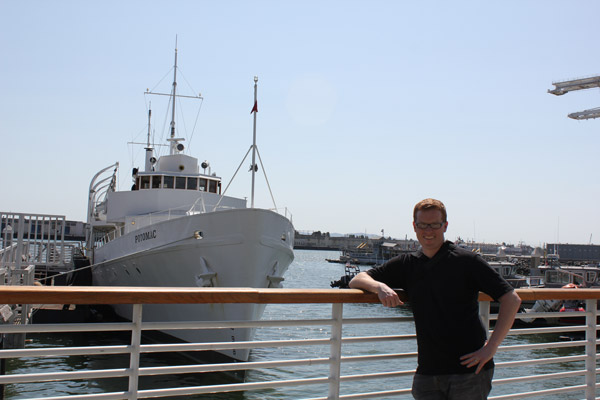
The USS Potomac, where FDR "relaxed" on the high seas.
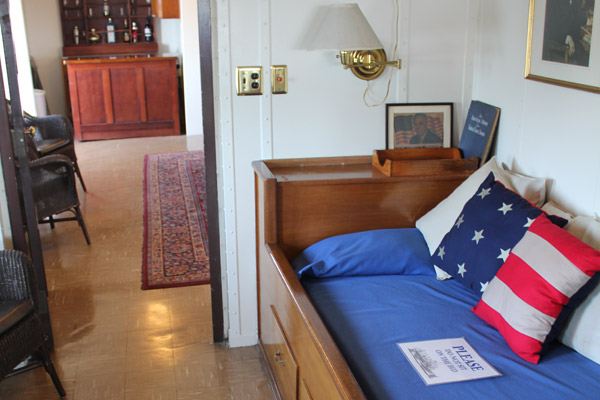
FDR's quarters. Note the lack coaming to accommodate his wheelchair.
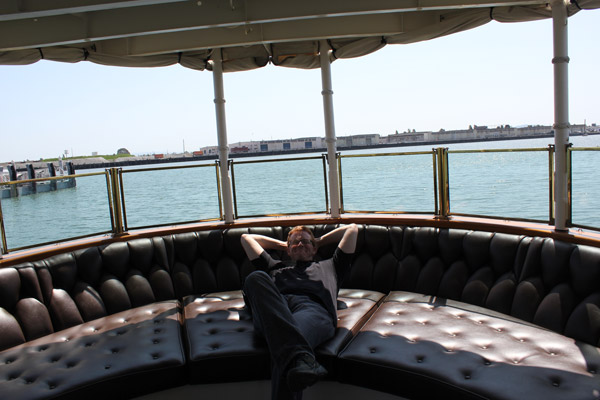
The extra deep bench at the rear of the USS Potomac. For fishing or macking.
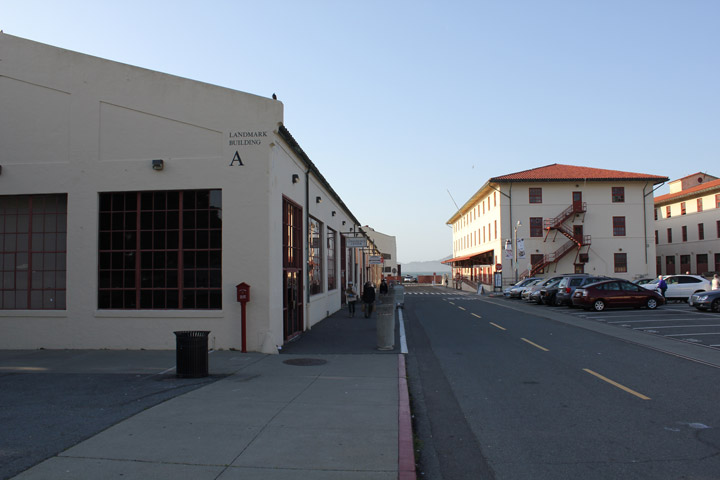
Fort Mason, a converted military station and our dinner destination.
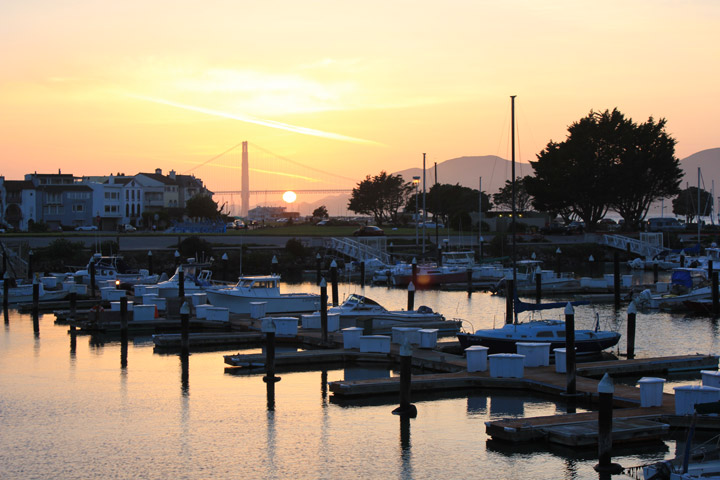
A gorgeous sunset as seen from Fort Mason.
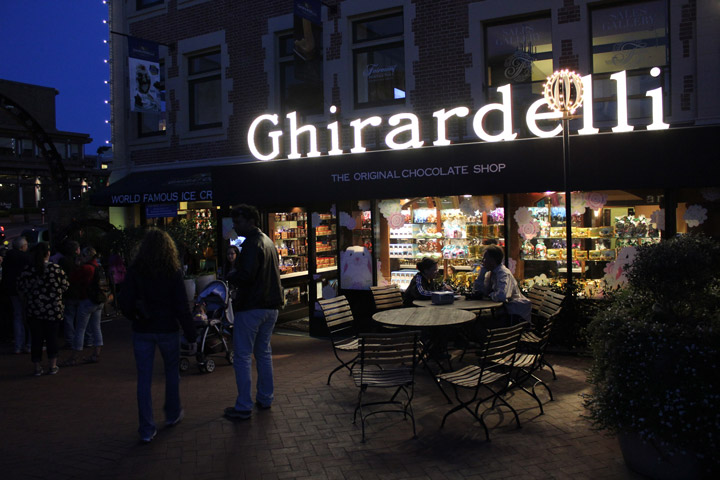
One of San Francisco's most famous (and sweetest) businesses.
To put it as politely, Oakland is a dump -- the vibe you got from watching Raiders games on TV was completely accurate. There's not much to see there if you're a casual tourist, but no one ever accused me of being casual. I wanted to see the USS Potomac.
Naturally, it has almost nothing to do with Oakland. The ship was built in the 1930s as a Coast Guard cutter -- the kind of vessel that would hunt down bootleggers. Franklin Roosevelt wanted a yacht, so it was transferred to his service. He used it for pleasure cruises and working vacations, until submarine warfare made presidential sea voyages a bad idea. After he died, it went back to the Coast Guard, and eventually got sold to private owners. Someone tried to take it to the Seattle World's Fair in 1962, but it crapped out on its way up the West Coast.
It kept changing hands. Elvis Presley bought the boat at one point, and he later donated it to a children's hospital, for sale at a fundraiser auction. Eventually it was used in a drug smuggling operation, got impounded by the U.S. government and was parked at Treasure Island -- a naval station in the middle of the San Francisco Bay. It sank while in the dock. The Potomac was beat to hell, almost beyond recognition; on the verge of getting scrapped, it was bought by the Port of Oakland. They restored it, opened it to tourists, and sat back to watch the money pour in.
Which is to say, we were the only people there. The Potomac is docked at the edge of Jack London Square, the bizzarro Fisherman's Wharf. The sidewalks and restaurants were mostly empty, everything is a little bit grimier, and the surrounding area is mildly bombed out. But on the positive side, we didn't have to pay $40 for parking! We put Bendy on the street. Please note that this is ominous foreshadowing.
Some people take a complete lack of crowds as a bad sign. I look at it as the chance for an exclusive private tour at regular admission rates. And it was totally worth it. We got to check out the huge diesel engines below decks; we saw the front cabin, where the famous Filipino stewards slept. They took us to the guest quarters, where King George VI took one look and politely declined to sleep on board. Roosevelt even used the ship's communications room to deliver a fireside chat.
There are also some intriguing handi-capable modifications. The entrances to FDR's cabin had no coaming, to accommodate his wheelchair. He had a giant specialty tub installed in his private bathroom. The stern of the boat had a giant custom couch, about four feet deep -- it was a great space for FDR to stretch out his crippled legs and go fishing. There was even a second (and false) smokestack added to the top deck, to serve as the cosmetic cover for the personal elevator that FDR needed.
Our guide was tremendous. He was used to leading tours for grade-schoolers, and I think he was happy to talk about FDR like an actual person. Roosevelt liked to claim that he was working non-stop for the nation during the Depression, but the records pretty clearly showed that he went cruising on the Chesapeake Bay all the time. He was rich snob at heart, and that's what rich snobs do.
Eleanor Roosevelt was almost never on the Potomac; she liked to claim that she wasn't fond of sailing, but there are a few photos of her having a fine time on ships a lot smaller than that Potomac. In reality, the ship was another place where FDR could take a mistress. Polio should never keep you from banging around as much as possible -- this is why FDR is an inspiration to disabled people everywhere. I casually slipped into conversation that we had also seen the USS Sequoia, the presidential yacht docked in Washington. Once the guide understood how cool we were, the tour seemed to be on a whole new level.
You have to ease off that kind of high, so on leaving the Potomac we cruised Jack London Square for a bit. Jack London was apparently from Oakland, and the centerpiece of the square is a cabin he once stayed in while living in Alaska. Or half of it, at least. A bunch of the logs were used in a replica somewhere in Canada, and the rest went to Oakland. So you have an Alaskan cabin surrounded by palm trees. There's also a wolf statue. Heeding the call of the wild, we walked away after two minutes and got some gelato.
And then, we got to have our one truly authentic Oakland experience. When we returned to our car, a rear window had been smashed, and the shoulder bag I had tucked under my seat was gone. Gone with it were our zoom lens, and my house key, and any chance that I will ever speak fondly of Oakland.
My wife is great in these situations. When things go wrong, I get tense and irritable; it's why I'll never be a famous stand-up comedian, or a neurosurgeon. Allyson has worked in customer service for years, and she has a freakish ability to get calmer when everyday situations turn to crap. If you ever need to move an inebriated and/or bleeding person off a bathroom floor, Allyson is your woman. I was all in favor of wandering the streets despondently for an hour. She busted out her cell phone and started making some calls.
As it turns out, the Oakland police don't get out of bed for anything short of stabbing. It would have been three hours before they came to us, so we had to go to a police substation a few blocks away. You haven't known true happiness until you've been in an Oakland police substation on Easter Sunday -- it was a small consolation that our lives were not the worst. A deaf woman was attempting to fill out a police report because her moving van was stolen.
The upshot was that we had to say goodbye to Bendy. After a few more phone calls, we found out that the closest rental office was at the Oakland Airport. The thief hadn't taken our Garmin -- even further proof of his stupidity -- so we punched in the address and got moving. It was an angry drive, cooled only by the air coming in the smashed rear window. After some paperwork and some interactions with depressingly unsurprised service reps, we had a Mitsubishi Gallant -- Allyson decided to name it Mickey -- and a grudge that will last a lifetime.
I hate Oakland. You should hate Oakland too.
In the grand scheme of things, we got off lucky. Every vacation lasting a week or longer has to have at least one significant setback. In Australia two years before, I got an ear infection; in Europe the year after that, I sort of got us into a boat crash. The only active mistake I made this time was leaving a bag in the car. We still had our camera, and our IDs, and our credit cards. We were able to get a new car within two hours, neither one of us was hurt, and nothing could possibly go wrong for the entire rest of our trip. Don't get me wrong, I still despise Oakland and all its residents, and if a 9.6 earthquake were to drop the whole city into the ocean, I would only mourn the loss of that guide from the Potomac.
But you can't let the setbacks ruin your entire trip. To that end, we hustled back over the Bay Bridge in time for a dinner reservation at Greens, a vegetarian joint at San Francisco's Fort Mason complex. The food was OK, and afterward we watched the sun set behind the Golden Gate Bridge. We stopped by Ghirardelli Square, the onetime HQ of the famous chocolate company; it's now a shopping complex that is mostly closed on Easter night. Then we hustled back to the Palace Hotel to watch a little "Game of Thrones."
We were just about done with San Francisco, and there wasn't too much more to squeeze out of the city -- we had enjoyed some fine dining, taken in some night life, toured a few historic sites, done a little shopping and had our natural rights violated. Our third day in California started on the punishment side of things and finally got around to crime. In a way, it had a quirky kind of balance, and we've already reached the point where we're laughing about it.
We'll laugh even harder when a meteorite directly strikes Oakland, but why get ahead of ourselves?
